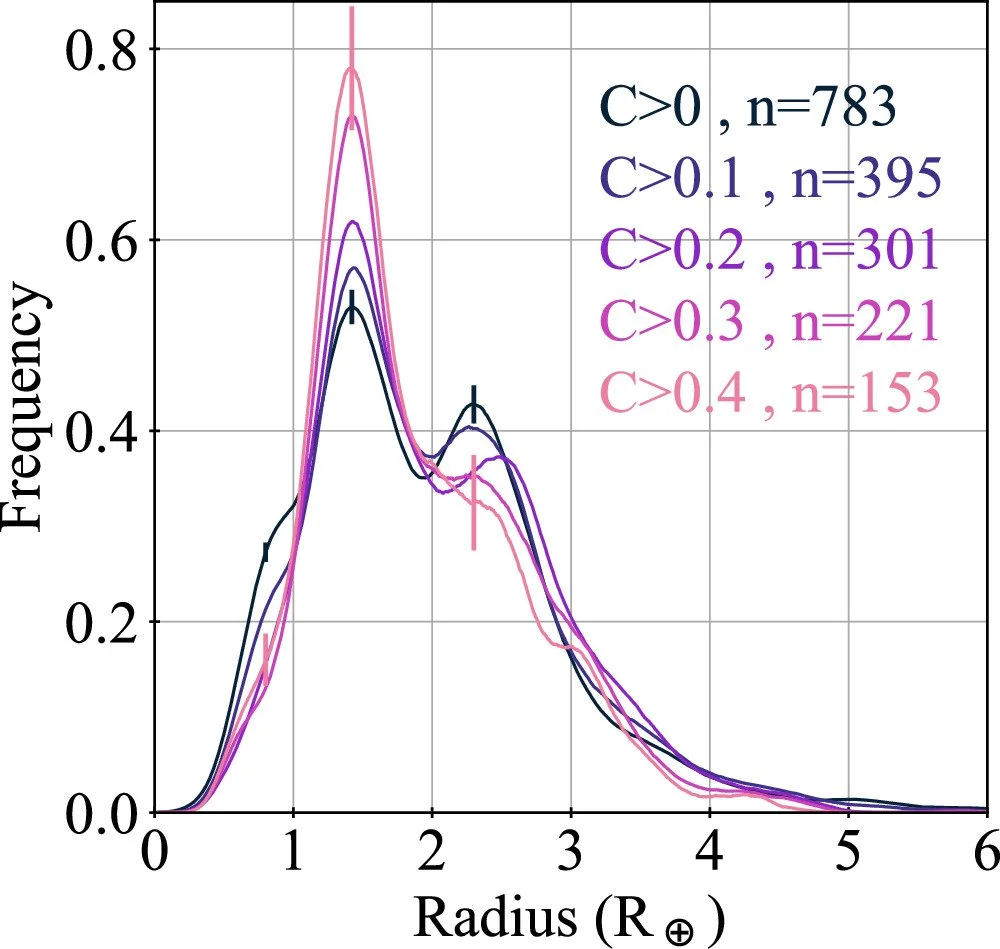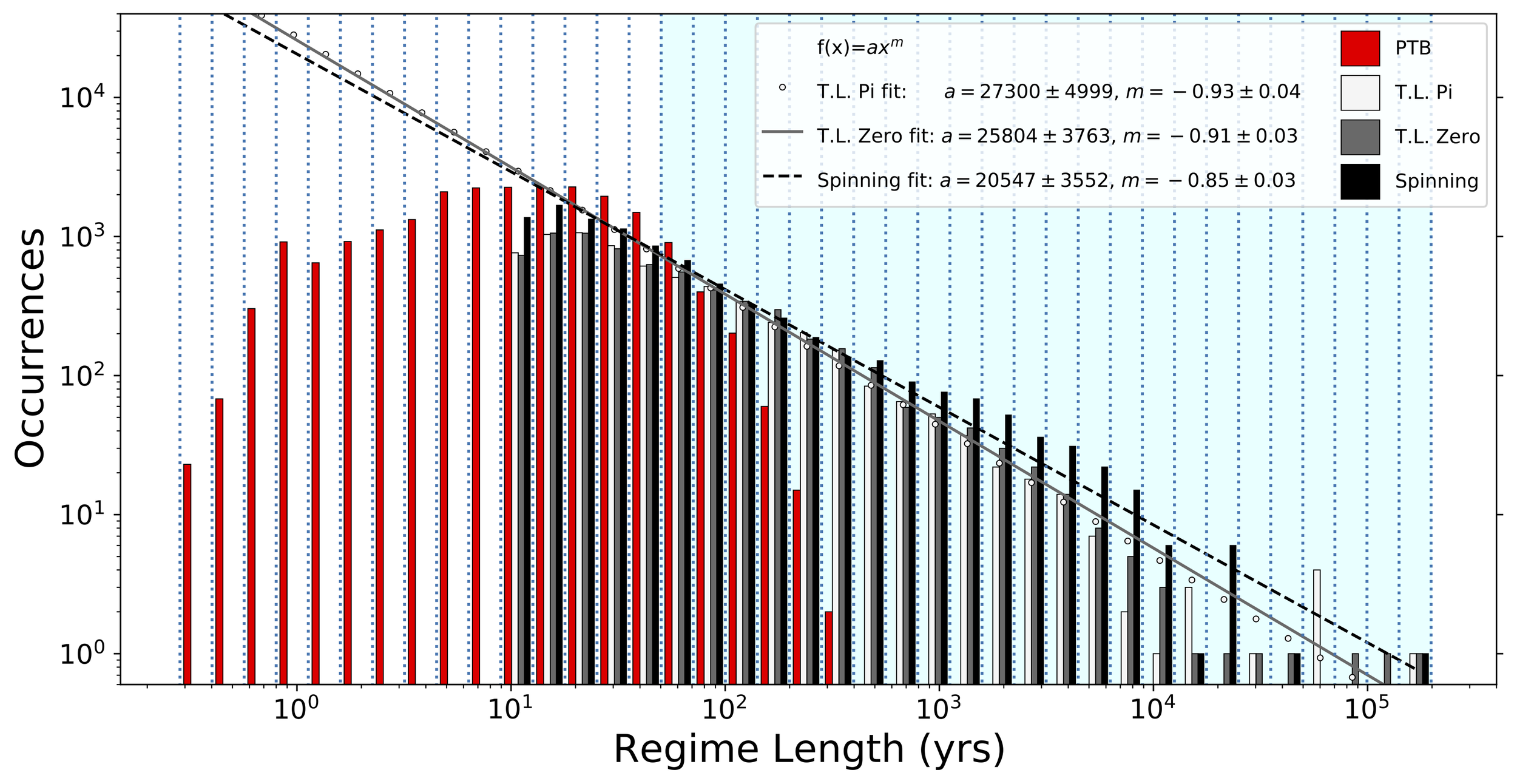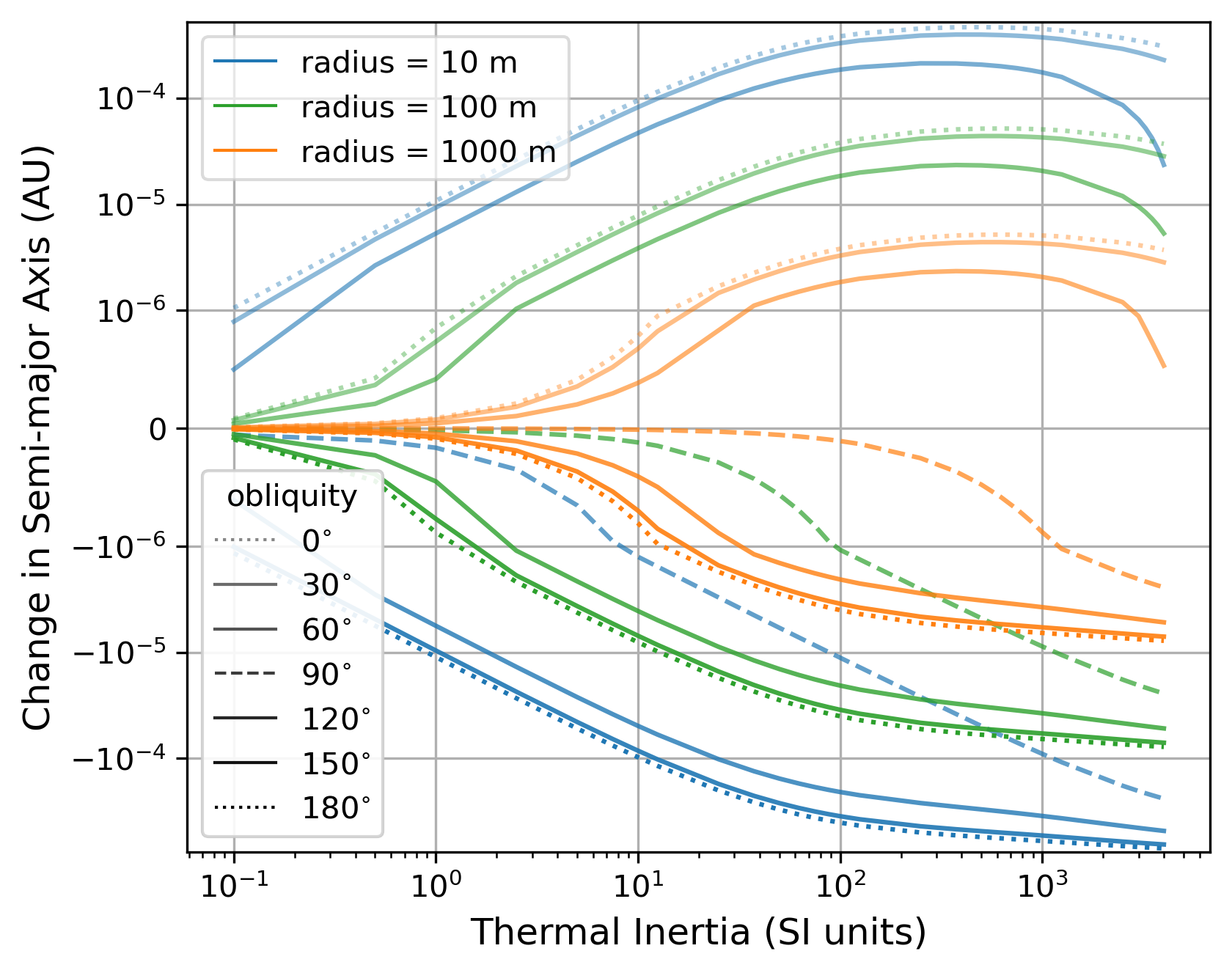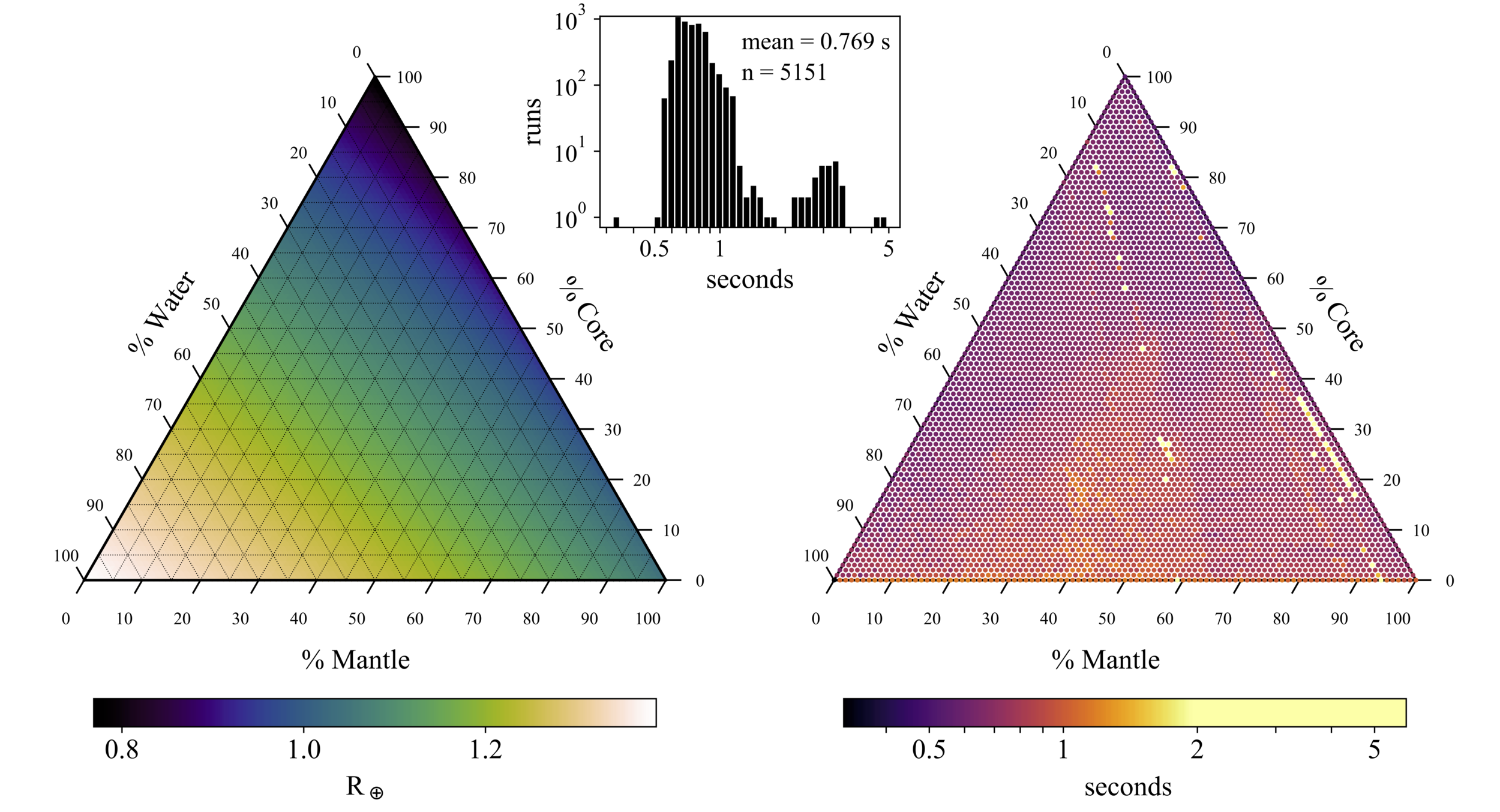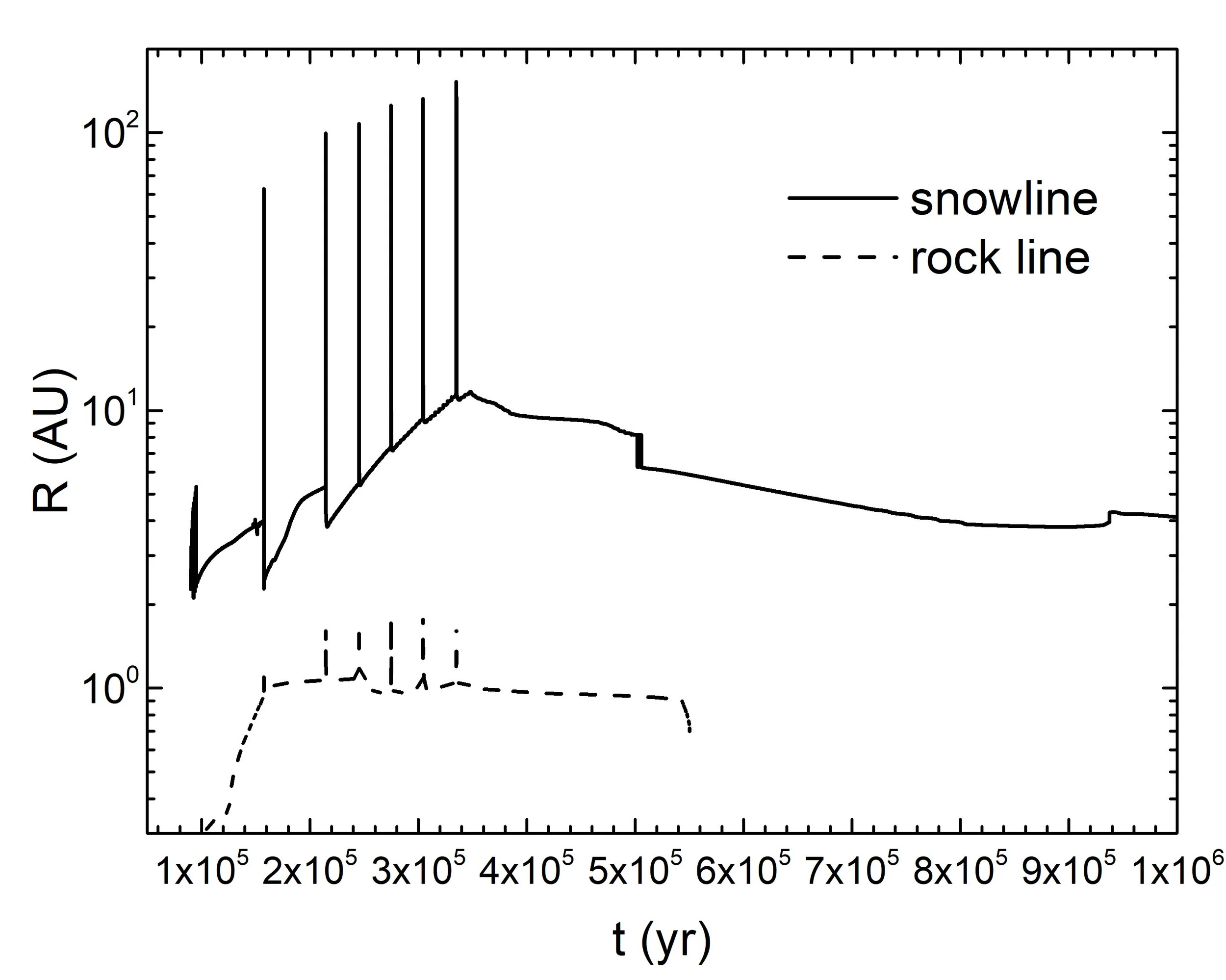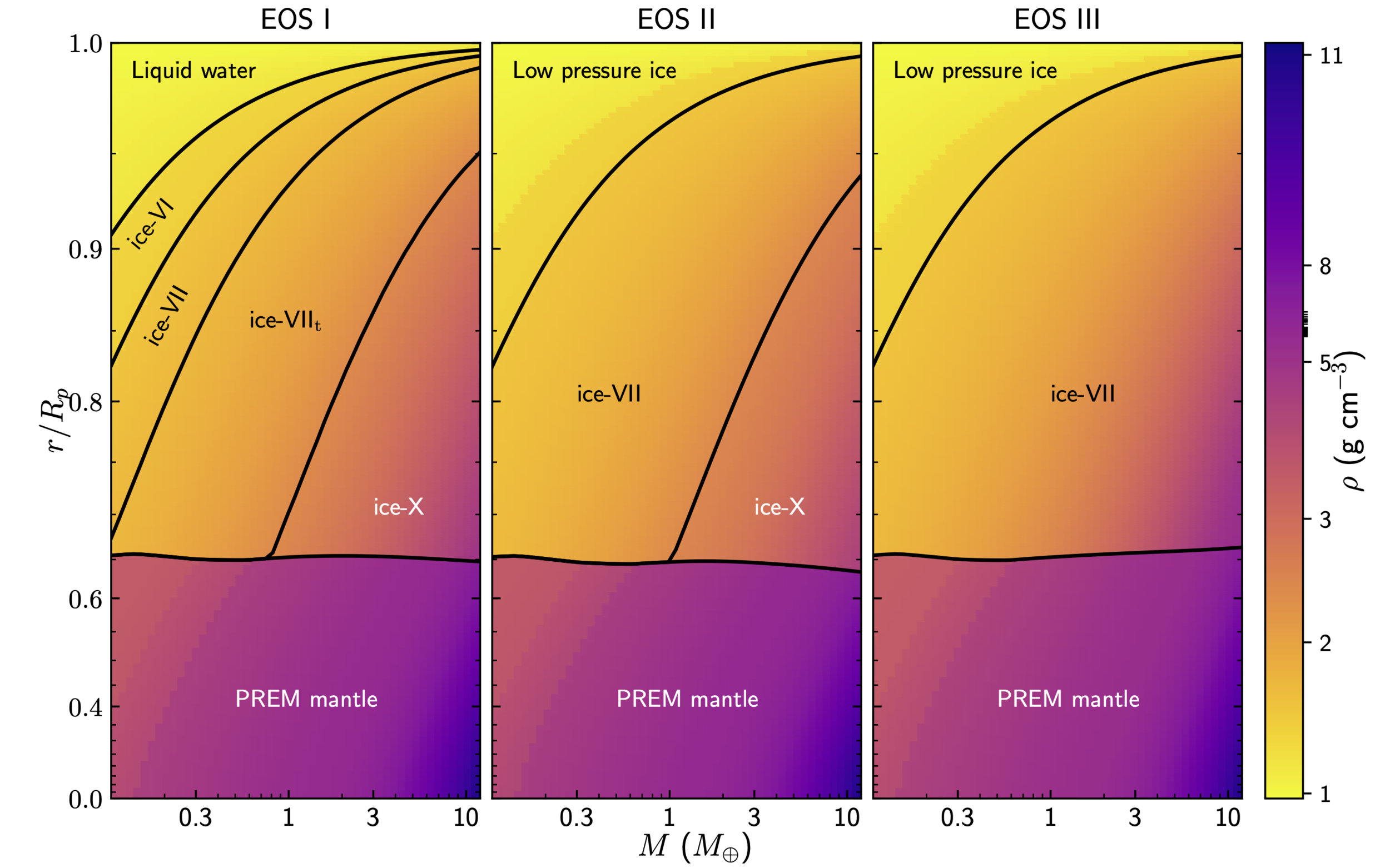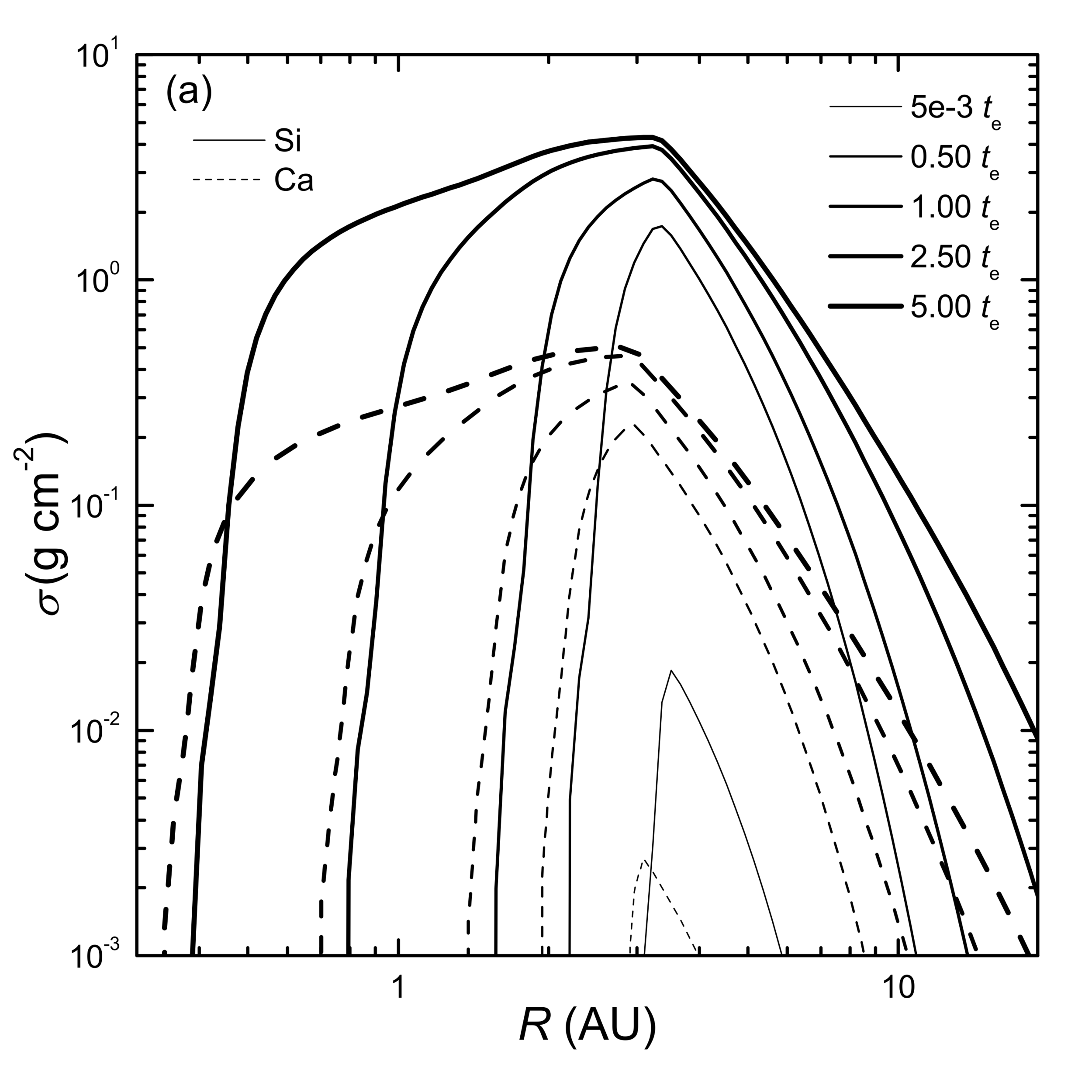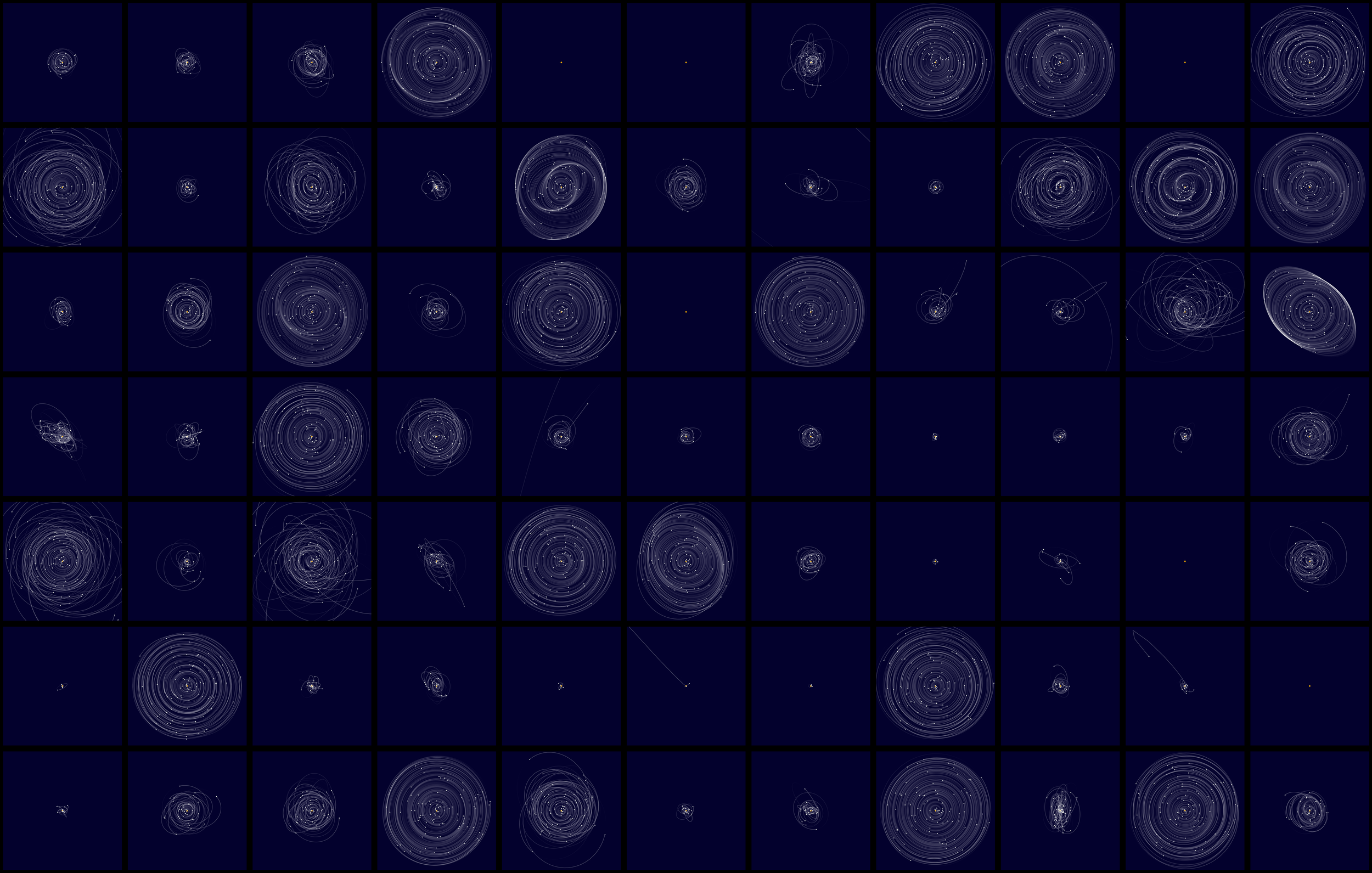Composition tracking for collisions between differentiated bodies in REBOUND
Authors: Ferich, Noah, Childs, Anna C., Steffen, Jason H.
Abstract: Previous research suggests that impacts between planetary embryos and planetesimals during the late stages of planet formation can often determine the percentages of core and mantle material that compose the newly formed planets in a system. Previous studies have attempted to include the composition-changing effects of these collisions in N-body simulations of planet formation, often as post-processing codes. In this paper, we present the Differentiated Body Composition Tracker, a new post-processing tool that uses collisional data collected from the N-body integrator REBOUND to determine the amount of core and mantle material that is transferred between colliding objects and the resulting fragments during an impact. We demonstrate how this code works using the data from 50 REBOUND simulations of planet formation and explore how the parameters in the code affect the core mass fractions of the remaining objects from these simulations. We then investigate how non-uniform distributions of core material across an initial disc affect the final core mass fractions of planets. Under ideal conditions, we find that a combination of giant impacts and planetary embryos enriched in core material could create some of the iron-rich planets that have been discovered.
Final Masses and Core Mass Fractions for the remaining objects in 50 REBOUND simulations with different distributions of core material in the initial disc. (a) shows the step-function distribution, (b) shows the linear distribution, and (c) shows the exponential distribution. The top row shows results from our Differentiated Body Composition Tracker (DBCT) and the bottom row shows results from the composition tracking code (CT) created by Childs and Steffen (2022). The blue, dotted line shows the initial mass given to embryos in each simulation, the orange, dash-dotted line shows the initial mass given to all planetesimals in each simulation, and the red, dashed line shows the average CMF of the initial disc for each distribution.
The Distribution of Planet Radius in Kepler Multiplanet Systems Depends on Gap Complexity
The median frequency of planet radius from 500 Gaussian KDEs where each planet's radius is drawn from a normal distribution centered at the planet's reported radius and standard deviation set the average of the plus and minus uncertainties. This is then repeated for each set of planets limited by minimum gap complexity given by the color. The 1σ uncertainty is given at three points for the entire set of planets and planets with C > 0.4. While the uncertainty increases from the smaller sample size, there is a systematic increase in super-Earth and a decrease in sub-Neptune frequency.
Authors: Rice, David R., Steffen, Jason H., Vazan, Allona
Abstract: The distribution of small planet radius (<4 R⊕) is an indicator of the underlying processes governing planet formation and evolution. We investigate the correlation between the radius distribution of exoplanets in Kepler multiplanet systems and the system-level complexity in orbital period spacing. Utilizing a sample of 234 planetary systems with three or more candidate planets orbiting FGK main-sequence stars, we measure the gap complexity (C) to characterize the regularity of planetary spacing and compare it with other measures of period spacing and spacing uniformity. We find that systems with higher gap complexity exhibit a distinct radius distribution compared to systems with lower gap complexity. Specifically, we find that the radius valley, which separates super-Earths and sub-Neptunes, is more pronounced in systems with lower gap complexity (C < 0.165). Planets in high-complexity systems (C > 0.35) exhibit a lower frequency of sub-Earths (2.5 times less) and sub-Neptunes (1.3 times less) and a higher frequency of super-Earths (1.4 times more) than planets in low-complexity systems. This may suggest that planetary systems with more irregular spacings are more likely to undergo dynamic interactions that influence planet scattering, composition, and atmospheric retention. The gap complexity metric proves to be a valuable tool in linking the orbital configurations of planets to their physical characteristics.
Composition constraints of the TRAPPIST-1 planets from their formation
Authors: Childs, Anna C., Shakespeare, Cody, Rice, David R., Yang, Chao-Chin, Steffen, Jason H.
Abstract: We study the formation of the TRAPPIST-1 (T1) planets starting shortly after Moon-sized bodies form just exterior to the ice line. Our model includes mass growth from pebble accretion and mergers, fragmentation, type-I migration, and eccentricity and inclination dampening from gas drag. We follow the composition evolution of the planets fed by a dust condensation code that tracks how various dust species condense out of the disc as it cools. We use the final planet compositions to calculate the resulting radii of the planets using a new planet interior structure code and explore various interior structure models. Our model reproduces the broader architecture of the T1 system and constrains the initial water mass fraction of the early embryos and the final relative abundances of the major refractory elements. We find that the inner two planets likely experienced giant impacts and fragments from collisions between planetary embryos often seed the small planets that subsequently grow through pebble accretion. Using our composition constraints we find solutions for a two-layer model, a planet comprised of only a core and mantle, that match observed bulk densities for the two inner planets b and c. This, along with the high number of giant impacts the inner planets experienced, is consistent with recent observations that these planets are likely dessicated. However, two-layer models seem unlikely for most of the remaining outer planets which suggests that these planets have a primordial hydrosphere. Our composition constraints also indicate that no planets are consistent with a core-free interior structure.
The average (with one-sigma error bars) wt% of water and the 12 elements we consider for each of our average simulated TRAPPIST-1 planets. Earth's values are shown in black. The bodies that begin with a water mass fraction (WMF) of 50% are shown in the top panel and the bodies that begin with a WMF of 20% are shown in the bottom panel.
Day and Night: Habitability of Tidally Locked Planets with Sporadic Rotation
Histogram of the combined regime occurrences over regime length for all simulations which exhibit Tidally Locked with Sporadic Rotation (TLSR) spin states. These include Tidally Locked with the initial substellar point at zero degrees and 180 degrees, as well as periods where the initial substellar point rotates and where it exhibits Prolonged Transient Behavior (PTB) as the planet transitions between states. The bin boundaries of the log-log histogram also use a log scale and are shown with dotted blue lines. The blue shaded area defines the 'well-behaved' sample data used to find the best-fit power laws for the probability density functions of the three regime types.
Authors: Shakespeare, Cody J. Steffen, Jason H.
Abstract: To more thoroughly study the effects of radiative forces on the orbits of small, astronomical bodies, we introduce the Yarkovsky effect into REBOUNDX, an extensional library for the N-body integrator REBOUND. Two different versions of the Yarkovsky effect (the "Full Version" and the "Simple Version") are available for use, depending on the needs of the user. We provide demonstrations for both versions of the effect and compare their computational efficiency with another previously implemented radiative force. In addition, we show how this effect can be used in tandem with other features in REBOUNDX by simulating the orbits of asteroids during the asymptotic giant branch phase of a 2 M ⊙ star. This effect is made freely available for use with the latest release of REBOUNDX.
Stable lifetime of compact, evenly spaced planetary systems with non-equal masses
Authors: David R. Rice and Jason H. Steffen
Abstract: Compact planetary systems with more than two planets can undergo orbital crossings from planet-planet perturbations. The time for which the system remains stable without orbital crossings has an exponential dependence on the initial orbital separations in units of mutual Hill radii. However, when a multiplanet system has period ratios near mean-motion resonances, its stability time differs from the time determined by planet separation. This difference can be up to an order of magnitude when systems are set-up with chains of equal period ratios. We use numerical simulations to describe the stability time relationship in non-resonant systems with equal separations but non-equal masses which breaks the chains of equal period ratios. We find a deviation of 30 per cent in the masses of Earth-mass planets that creates a large enough deviation in the period ratios where the average stability time of a given spacing can be predicted by the stability time relationship. The mass deviation where structure from equal period ratios is erased increases with planet mass but does not depend on planet multiplicity. With a large enough mass deviation, the distribution of stability time at a given spacing is much wider than in equal-mass systems where the distribution narrows due to period commensurabilities. We find the stability time distribution is heteroscedastic with spacing - the deviation in stability time for a given spacing increases with said spacing.
Stability time for suites of simulations with non-equal-mass planets. The mass of each planet in the system is chosen from a normal distribution with a mean of one Earth mass and with the standard deviation indicated.
The Yarkovsky Effect in REBOUNDx
Change in the semimajor axes of asteroids with different obliquities, thermal inertias, and radii after a 0.01 Myr long simulation on a log-log plot. Obliquities are denoted by opacity and radii are shown using color. A dashed line indicates an obliquity of 90° where the body’s semimajor axis is only affected by the seasonal component of the Yarkovsky effect, and a dotted line indicates an obliquity of 0° or 180° where the diurnal component’s effect on the object’s semimajor axis is at a maximum.
Authors: Ferich, Noah; Baronett, Stanley A.; Tamayo, Daniel; and Steffen, Jason H.
Abstract: To more thoroughly study the effects of radiative forces on the orbits of small, astronomical bodies, we introduce the Yarkovsky effect into REBOUNDX, an extensional library for the N-body integrator REBOUND. Two different versions of the Yarkovsky effect (the "Full Version" and the "Simple Version") are available for use, depending on the needs of the user. We provide demonstrations for both versions of the effect and compare their computational efficiency with another previously implemented radiative force. In addition, we show how this effect can be used in tandem with other features in REBOUNDX by simulating the orbits of asteroids during the asymptotic giant branch phase of a 2 M ⊙ star. This effect is made freely available for use with the latest release of REBOUNDX.
Exoplanets IV Conference
After two years of meeting primarily online, over 500 exoplanet scientists gathered in Las Vegas to collaborate, and share their scientific results. Exoplanets IV
Next stop for this series will be in Leiden, Netherlands.
Conference photo for Exoplanets IV
Pressure driven symmetry transitions in dense H2O ice
X-ray diffraction images without (left) and with (right) a new laser heating method to reduce systematic uncertainties in high pressure measurements. “D” marks diffraction spots from diamonds. The goal is to measure the radii of circles that pass through the remaining points. Note that the method used on the right shows high-quality circles, making them easier to measure.
Authors: Zachary M. Grande, C. Huy Pham, Dean Smith, John H Boisvert, Chenliang Huang, Jesse S. Smith, Nir Goldman, Jonathan L. Belof, Oliver Tschauner, Jason H. Steffen, and Ashkan Salamat
Abstract: X-ray diffraction and Raman spectroscopy of H2O (ice) structures are measured under static compression in combination with grain normalizing heat treatment via direct laser heating. We report the transition from cubic ice-VII to a structure of tetragonal symmetry, ice-VIIt at 5.1±0.5GPa. This is succeeded by the H-bond symmetrization transition occurring at a pressure of 30.9 ± 3 GPa. Both experimental observations are supported by simulated Raman spectra from Density Functional Theory quantum calculations. The transition to H-bond symmetrization is evidenced by the reversible emergence of its characteristic Raman mode and a 2.5-fold increase in bulk modulus, implying a significant increase in bonding strength.
Collisional fragmentation and bulk composition tracking in REBOUND
Authors: Anna C. Childs and Jason H. Steffen
We present a fragmentation module and a composition tracking code for the n-body code REBOUND. Our fragmentation code utilises previous semi-analytic models and follows an implementation method similar to fragmentation for the n-body code MERCURY. In our n-body simulations with fragmentation, we decrease the collision and planet formation timescales by inflating the particle radii by an expansion factor f and experiment with various values of f to understand how expansion factors affect the collision history and final planetary system. As the expansion factor increases, so do the rate of mergers which produces planetary systems with more planets and planets at larger orbits. Additionally, we present a composition tracking code which follows the compositional change of homogeneous bodies as a function of mass exchange and use it to study how fragmentation and the use of an expansion factor affects volatile delivery to the inner terrestrial disc. We find that fragmentation enhances radial mixing relative to perfect merging and that on average, as f increases so does the average water mass fraction of the planets. Radial mixing decreases with increasing f as collisions happen early on, before the bodies have time to grow to excited orbits and move away from their original location.
Water mass fraction of planets formed from the same initial conditions (top) with fragmentation (middle) and with perfect merging (bottom).
MAGRATHEA: an open-source spherical symmetric planet interior structure code
Results of planetary interior models with differing compositions and the time required to execute the model.
Authors: Chenliang Huang, David R. Rice, Jason H. Steffen
Abstract: MAGRATHEA is an open-source planet structure code that considers the case of fully differentiated spherically symmetric interiors. Given the mass of each layer, the code iterates the hydrostatic equations in order to shoot for the correct planet radius. The density may be discontinuous at a layer's boundary whose location is unknown. Therefore, in our case, shooting methods, which do not require predefined grid points, are preferred over relaxation methods in solving the two-point boundary value problem. The first version of MAGRATHEA supports a maximum of four layers of iron, silicates, water, and ideal gas. The user has many options for the phase diagram and equation of state in each layer and we document how to change/add additional equations of state. In this work, we present MAGRATHEA capabilities and discuss its applications. We encourage the community to participate in the development of MAGRATHEA at this URL.
Stellar Evolution and Tidal Dissipation in REBOUNDx
Authors: Stanley A. Baronett, Noah Ferich, Daniel Tamayo, Jason H. Steffen
Abstract: We introduce two new features to REBOUNDx, an extended library for the N-body integrator REBOUND. The first is a convenient parameter interpolator for coupling different physics and integrators using numerical splitting schemes. The second implements a constant time lag model for tides (without evolving spins) from Hut (1981). We demonstrate various examples of these features using post-main sequence stellar evolution data from MESA (Modules for Experiments in Stellar Astrophysics). These additional effects are publicly available as of REBOUNDx's latest release.
Orbital evolution of different planets as the Sun evolves.
Stellar outbursts and chondrite composition
Time evolution of the snow and rock lines due to stellar outbursts.
Authors: Min Li, Zhaohuan Zhu, Shichun Huang, Ning Sui, Michail I. Petaev, Jason H. Steffen
Abstract: The temperatures of observed protoplanetary disks are not sufficiently high to produce the accretion rate needed to form stars, nor are they sufficient to explain the volatile depletion patterns in CM, CO, and CV chondrites and terrestrial planets. We revisit the role that stellar outbursts, caused by high accretion episodes, play in resolving these two issues. These outbursts provide the necessary mass to form the star during the disk lifetime, and enough heat to vaporize planet-forming materials. We show that these outbursts can reproduce the observed chondrite abundances at distances near one AU. These outbursts would also affect the growth of calcium-aluminum-rich inclusions (CAIs) and the isotopic compositions of carbonaceous and non-carbonaceous chondrites.
Implications of an improved water equation of state for water-rich planets
Authors: Chenliang Huang, David R. Rice, Zachary M. Grande, Dean Smith, Jesse S. Smith, John H. Boisvert, Oliver Tschauner, Ashkan Salamat, Jason H. Steffen
Abstract: Water (H2O), in all forms, is an important constituent in planetary bodies, controlling habitability and influencing geological activity. Under conditions found in the interior of many planets, as the pressure increases, the H-bonds in water gradually weaken and are replaced by ionic bonds. Recent experimental measurements of the water equation of state (EOS) showed both a new phase of H-bonded water ice, ice-VIIt, and a relatively low transition pressure just above 30 GPa to ionic bonded ice-X, which has a bulk modulus 2.5 times larger. The higher bulk modulus of ice-X produces larger planets for a given mass, thereby either reducing the atmospheric contribution to the volume of many exoplanets or limiting their water content. We investigate the impact of the new EOS measurements on the planetary mass-radius relation and interior structure for water-rich planets. We find that the change in the planet mass-radius relation caused by the systematic differences between previous and new experimental EOS measurements are comparable to the observational uncertainties in some planet sizes -- an issue that will become more important as observations continue to improve.
Internal structure of water-rich planets using a new equation of state.
Giant planet effects on terrestrial planet formation and system architecture
Loss of planet forming material in the presence of outer giant planets.
Authors: Anna C. Childs, Elisa Quintana, Thomas Barclay, Jason H. Steffen
Abstract: The giant planets of the solar system likely played a large role in shaping the architecture of the terrestrial planets. Using an updated collision model, we conduct a suite of high resolution N-body integrations to probe the relationship between giant planet mass, and terrestrial planet formation and system architecture. We vary the mass of the planets that reside at Jupiter's and Saturn's orbit and examine the effects on the interior terrestrial system. We find a correlation between the mass of the exterior giant planets and the collision history of the resulting planets, which holds implications for the planet's properties. More massive giants also produce terrestrial planets that are on smaller, more circular orbits. We do not find a strong correlation between exterior giant planet mass and the number of Earth-analogs (analogous in mass and semi-major axis) produced in the system. These results allow us to make predictions on the nature of terrestrial planets orbiting distant Sun-like star systems that harbor giant planet companions on long orbits---systems which will be a priority for NASA's upcoming Wide-Field Infrared Space Telescope (WFIRST) mission.
Survival of non-coplanar, closely-packed planetary systems after a close encounter
Authors: David R. Rice, Frederic A. Rasio, Jason H. Steffen
Abstract: Planetary systems with more than two bodies will experience orbital crossings at a time related to the initial orbital separations of the planets. After a crossing, the system enters a period of chaotic evolution ending in the reshaping of the system's architecture via planetary collisions or ejections. We carry out N-body integrations on a large number of systems with equally-spaced planets (in units of the Hill radius) to determine the distribution of instability times for a given planet separation. We investigate both the time to the initiation of instability through a close encounter and the time to a planet-planet collision. We find that a significant portion of systems with non-zero mutual inclinations survive after a close encounter and do not promptly experience a planet-planet collision. Systems with significant inclinations can continue to evolve for over 1,000 times longer than the encounter time. The fraction of long lived systems is dependent on the absolute system scale and the initial inclination of the planets. These results have implications to the assumed stability of observed planetary systems.
Ratio of collision time to encounter time for unstable planetary systems compared to the relative orbital inclination of those planets.
Maximum temperatures in evolving protoplanetary discs and composition of planetary building blocks
Fraction of constant alpha disk models that reach a specified peak temperature.
Authors: Min Li, Shichun Huang, Michail I. Petaev, Zhaohuan Zhu, Jason H. Steffen
Abstract: The maximum temperature and radial temperature profile in a protoplanetary disc are important for the condensation of different elements in the disc. We simulate the evolution of a set of protoplanetary discs from the collapse of their progenitor molecular cloud cores as well as the dust decoupling within the discs as they evolve. We show how the initial properties of the cloud cores affect the thermal history of the protoplanetary discs using a simple viscous disc model. Our results show that the maximum mid-plane temperature in the disc occurs within 0.5 au. It increases with the initial cloud temperature and decreases with its angular velocity and the viscosity of the disc. From the observed properties of the molecular cloud cores, we find the median value of the maximum temperature is around 1250 K, with roughly 90 per cent of them being less than 1500 K - a value that is lower than the 50 per cent condensation temperatures of most refractory elements. Therefore, only cloud cores with high initial temperatures or low-angular velocities and/or low viscosities within the planet-forming discs will result in refractory-rich planetesimals. To reproduce the volatile depletion pattern of CM, CO, and CV chondrites and the terrestrial planets in Solar system, one must either have rare properties of the initial molecular cloud cores like high core temperature, or other sources of energy to heat the disc to sufficiently high temperatures. Alternatively, the volatile depletion observed in these chondrites may be inherited from the progenitor molecular cloud.
Dust Condensation in Evolving Discs and the Composition of Planetary Building Blocks
Authors: Min Li, Shichun Huang, Michail I. Petaev, Zhaohuan Zhu, Jason H. Steffen
Abstract: Partial condensation of dust from the Solar nebula is likely responsible for the diverse chemical compositions of chondrites and rocky planets/planetesimals in the inner Solar system. We present a forward physical-chemical model of a protoplanetary disc to predict the chemical compositions of planetary building blocks that may form from such a disc. Our model includes the physical evolution of the disc and the condensation, partial advection, and decoupling of the dust within it. The chemical composition of the condensate changes with time and radius. We compare the results of two dust condensation models: one where an element condenses when the midplane temperature in the disc is lower than the 50% condensation temperature (T50) of that element and the other where the condensation of the dust is calculated by a Gibbs free energy minimization technique assuming chemical equilibrium at local disc temperature and pressure. The results of two models are generally consistent with some systematic differences of ∼10% depending upon the radial distance and an element's condensation temperature. Both models predict compositions similar to CM, CO, and CV chondrites provided that the decoupling timescale of the dust is on the order of the evolution timescale of the disc or longer. If the decoupling timescale is too short, the composition deviates significantly from the measured values. These models may contribute to our understanding of the chemical compositions of chondrites, and ultimately the terrestrial planets in the solar system, and may constrain the potential chemical compositions of rocky exoplanets.
Evolving surface density of Calcium and Silicon in a protoplanetary disk.
Survivability of Moon Systems Around Ejected Gas Giants
Orbits of moons that survive planetary ejections.
Authors: Ian Rabago, Jason H. Steffen
Abstract: We examine the effects that planetary encounters have on the moon systems of ejected gas giant planets. We conduct a suite of numerical simulations of planetary systems containing three Jupiter-mass planets (with the innermost planet at 3 AU) up to the point where a planet is ejected from the system. The ejected planet has an initial system of 100 test-particle moons. We determine the survival probability of moons at different distances from their host planet, measure the final distribution of orbital elements, examine the stability of resonant configurations, and characterize the properties of moons that are stripped from the planets. We find that moons are likely to survive in orbits with semi-major axes out beyond 200 planetary radii (0.1 AU in our case). The orbital inclinations and eccentricities of the surviving moons are broadly distributed and include nearly hyperbolic orbits and retrograde orbits. We find that a large fraction of moons in two-body and three-body mean-motion resonances also survive planetary ejection with the resonance intact. The moon-planet interactions, especially in the presence of mean-motion resonance, can keep the interior of the moons molten for billions of years via tidal flexing, as is seen in the moons of the gas giant planets in the solar system. Given the possibility that life may exist in the subsurface ocean of the Galilean satellite Europa, these results have implications for life on the moons of rogue planets---planets that drift through the galaxy with no host star
Dynamical instability and its implications for planetary system architecture
Authors: Dong-Hong Wu, Rachel C. Zhang, Ji-Lin Zhou, Jason H. Steffen
Abstract: We examine the effects that dynamical instability has on shaping the orbital properties of exoplanetary systems. Using N-body simulations of non-EMS (Equal Mutual Separation), multi-planet systems we find that the lower limit of the instability timescale t is determined by the minimal mutual separation Kmin in units of the mutual Hill radius. Planetary systems showing instability generally include planet pairs with period ratio <1.33. Our final period ratio distribution of all adjacent planet pairs shows dip-peak structures near first-order mean motion resonances similar to those observed in the Kepler planetary data. Then we compare the probability density function (PDF) of the de-biased Kepler period ratios with those in our simulations and find a lack of planet pairs with period ratio >2.1 in the observations---possibly caused either by inward migration before the dissipation of the disk or by planet pairs not forming with period ratios >2.1 with the same frequency they do with smaller period ratios. By comparing the PDF of the period ratio between simulation and observation, we obtain an upper limit of 0.03 on the scale parameter of the Rayleigh distributed eccentricities when the gas disk dissipated. Finally, our results suggest that a viable definition for a `packed' or `compact' planetary system be one that has at least one planet pair with a period ratio less than 1.33. This criterion would imply that 4% of the Kepler systems (or 6% of the systems with more than two planets) are compact.
Period ratio distribution arising from dynamical instability with different initial eccentricity and inclination distributions and compared with Kepler observations (black).
Systematic mischaracterization of exoplanetary system dynamical histories from a model degeneracy near mean-motion resonance
Possible planet pairs mischaracterized as single planets with eccentric orbits.
Authors: John H. Boisvert, Benjamin E. Nelson, Jason H. Steffen
Abstract: There is a degeneracy in the radial velocity exoplanet signal between a single planet on an eccentric orbit and a two-planet system with a period ratio of 2:1. This degeneracy could lead to misunderstandings of the dynamical histories of planetary systems as well as measurements of planetary abundances if the correct architecture is not established. We constrain the rate of mischaracterization by analyzing a sample of 60 non-transiting, radial velocity systems orbiting main sequence stars from the NASA Exoplanet Archive (NASA Archive) using a new Bayesian model comparison pipeline. We find that 15 systems (25% of our sample) show compelling evidence for the two-planet case with a confidence level of 95%.

